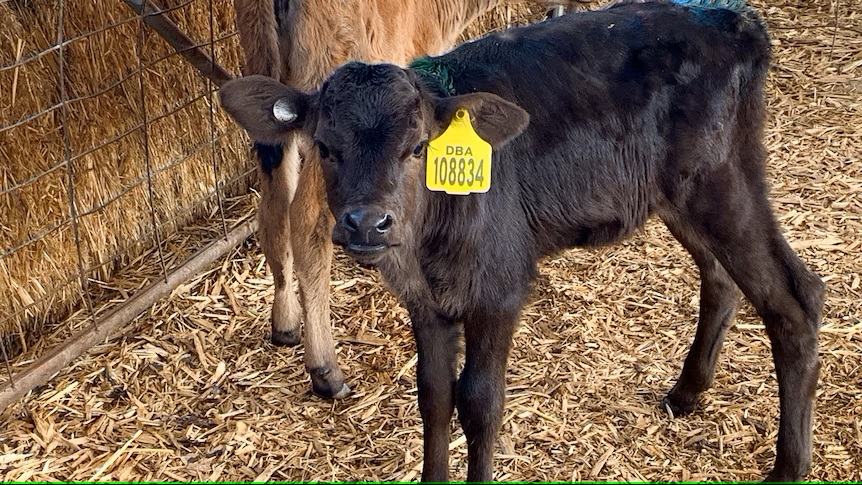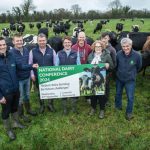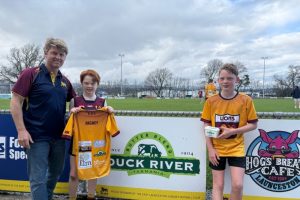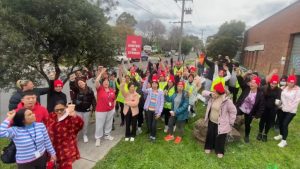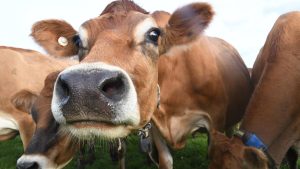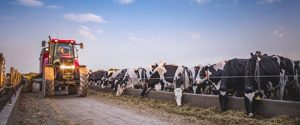
Victorian dairy farmer Roisin Powles says farmers do not like killing newborn bobby calves on farms or sending them to abattoirs.
But she says it has long been the only option.
“Nobody likes it. I think they just see it as the only solution.”
Bobby calves are the unwanted young of dairy cows, which are removed from their mothers from as young as one-day-old and either killed instantly or in the coming days.
Cows must get pregnant to produce milk for the dairy industry but less than 20 per cent of female calves are required as replacement milkers.
Victorian dairy farmer Roisin Powles no longer sends bobby calves away for slaughter. (ABC News)
In Australia, between 200,000 and 500,000 bobby calves are killed annually.
Dairy Australia’s Sustainable Animal Care manager, Andy Hancock, said that was up to 40 per cent of the number of dairy calves born each year.
He said with the public opposed to killing healthy calves, doing nothing wasn’t an option.
“It’s something that could turn around and bite us,” Mr Hancock said.
“We need to show the community and regulators we’re doing something, that we’re moving the needle on this.”
Dairy Australia has set a 10-year goal to find more humane ways of dealing with bobby calves, considered a living waste by-product.
However, the 2035 date has been criticised as unambitious and a threat to the industry’s social licence.
Calves destined for early slaughter
Healthy bobby calves are killed because there is no other use for them for the dairy industry. (ABC News: Pip Courtney)
RSPCA’s Natalie Roadknight said the public generally reacted negatively when they found out what happened to bobby calves.
“That tells you that the current practices on dairy farms are out of step with community expectations,” Dr Roadknight said.
“They’re under 30 days old, they’re not with their mother, and they’re usually destined for early slaughter.”
A growing number of dairy farmers are breeding their cows with beef bulls so their offspring can be sold for meat.
Beef-dairy cross calves prolong life
Calves destined for meat production grow for at least two years before being processed.
Retailer Gerry Harvey was an early beef-on-dairy pioneer.
He invested in Wagyu beef 23 years ago and when he didn’t have enough Wagyu females, he set up the Dairy Beef Alliance (DBA) business.
Calves are sent to contractors who rear them until they are three months old. (ABC Landline: Pip Courtney)
DBA offered to buy dairy calves if farmers got some of their milking cows pregnant to his Wagyu bulls.
The calves then became valuable to both the dairy farmer and DBA.
Merv Koch says crossbreeding has been a win for them. (ABC News: Pip Courtney)
Northern Victorian dairy farmers Merv and Bonita Koch started supplying calves to DBA 16 years ago and said it helped them build their Holstein herd from 250 to 750.
“It was definitely a win-win for us.”
The Kochs bottle-feed the calves for seven days before they pass them onto contract calf-rearer Tracy Todd, who raises them for three months.
At peak times, she feeds 500 calves.
She wants Australia’s beef-on-dairy industry to grow so more calves can live longer, high-welfare lives.
Tracy Todd says contract rearing gives the calves a longer life span. (ABC News: Pip Courtney )
“When you see them on the truck, it’s not a nice sight, but doing it this way they’re surviving. They’re growing up,” Ms Todd said.
“They’re not getting their heads cut off and they’ve got a good life.”
The three-month-old calves move to a grazing property for nine months and then to a feedlot for 400 days.
The Holstein-Wagyu cross beef is sold to premium markets in 30 countries.
About 250 dairy farmers supply 10,000 calves a year to DBA.
Bias dairy cattle doesn’t produce good meat
Mr Koch (left) and Dairy Beef Alliance general manager Peter Wilkinson. (ABC News: Pip Courtney)
DBA’s general manager, Peter Wilkinson, said the dairy-beef cattle achieved high-quality meat marble scores with 70 per cent of the cuts scoring at least seven out of nine.
“There’s marbling that comes in from Holsteins that people don’t realise is there,” Mr Wilkinson said.
“They also bring a lot of frame and volume into the animals we produce, and, obviously, those forequarter cuts are the higher value cuts, and they’re bigger in that area.”
Mr Wilkinson said most of DBA’s beef was exported for higher prices than what Australian buyers would pay because there was a bias that dairy cattle didn’t produce high-quality beef.
But if the dairy industry’s 2035 deadline was to be achieved, the RSPCA’s Dr Roadknight said that must change.
“If there’s going to be a pathway for these bobby calves, then it’s going to be both industries working together because they do become beef animals,” she said.
“So they’re part of both the beef and the dairy industry.”
These livestock are the product of dairy cattle crossed with a beef breed. (ABC News: Cam Lang)
Beef processor Greenham has 150 dairy farmers in Tasmania and Victoria supplying beef-dairy cross calves for its grass-fed beef-on-dairy brand.
Greenham welfare manager Sarah Bolton said about 90 per cent of the beef was exported, mostly going to the United States, which, unlike Australia, has a thriving beef-on-dairy sector.
“Our product actually meets the same specifications as what a purebred beef animal does,” she said.
A joint trial between the Queensland Department of Agriculture and Fisheries (DAFF) and the University of Queensland is gathering data on the performance of dairy and beef-on-dairy cattle.
“It’s fantastic news, which means people [dairy farmers] have got a product they can actually do something with,” Mr Bauer said.
Mr Bauer said the cattle’s eating quality earned UQ a place in Queensland’s top 100 beef producers list last year.
“You think about the level of discrimination, you always hear about dairy-derived animals [but] the consistency and the level of the improvement over the standard probably was surprising.”
Mark Bauer says the success of crossbreeding is fantastic news. (ABC News: Cam Lang)
You can now read the most important #news on #eDairyNews #Whatsapp channels!!!
🇺🇸 eDairy News INGLÊS: https://whatsapp.com/channel/0029VaKsjzGDTkJyIN6hcP1K
